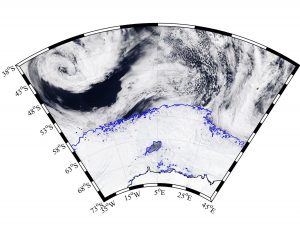In 2018, we wrote about Antarctica’s unsettling “blood waterfall.” Now, you can check out a fascinating short documentary about the crimson cascade filmed in 2020:
Tag: Antarctica
Antarctica’s unsettling blood waterfall

Nature’s marvels are boundless, and one of its most visually disturbing is a certain blood-red cascade found in Victoria Land, East Antarctica (aptly named “Blood Falls“). Fortunately for the squeamish, it’s not actually blood:
Blood Falls is an outflow of an iron oxide-tainted plume of saltwater, flowing from the tongue of Taylor Glacier onto the ice-covered surface of West Lake Bonney in the Taylor Valley of the McMurdo Dry Valleys in Victoria Land, East Antarctica.
Iron-rich hypersaline water sporadically emerges from small fissures in the ice cascades. The saltwater source is a subglacial pool of unknown size overlain by about 400 metres (1,300 ft) of ice several kilometers from its tiny outlet at Blood Falls.
The reddish deposit was found in 1911 by the Australian geologist Griffith Taylor, who first explored the valley that bears his name. The Antarctica pioneers first attributed the red color to red algae, but later it was proven to be due to iron oxides.
Surely a sight to see! Given the remote location of Blood Falls, though, it’s unlikely to appeal as a tourist destination to any but the hardiest and most well-heeled of travelers.
Huge, mysterious hole opens up in Antarctica

A massive, 30,000 square mile hole has just opened up in the Antarctic ice. (For reference, that’s roughly the size of the state of Maine, the surface of Lake Superior, or the entire nation of Belgium.) A hole such as this — an area of open water surrounded by sea ice — is called a polynya. This particular polynya is located in the Weddell Sea, and while its appearance is puzzling, it is not unprecedented: a similar hole was observed in the region in the 1970s. Precisely what led to the formation of the Weddell Sea polynya is unknown. A typical polynya forms close to open water; this one, however, is “deep in the ice pack” and thus “must have formed through other processes that aren’t understood.”1
While scientific data on the 1970s Weddell Sea polynya is limited to a few photographs taken by early satellites, technological advances since that time offer researchers greater ability to study — and perhaps understand — the hole’s recurrence. As to precisely what caused this hole to open up, I have my own theory:
